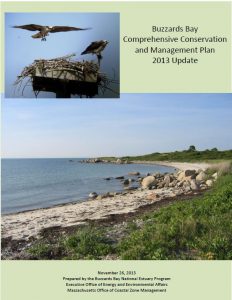2013 CCMP, Action Plan 10:
Managing Water Withdrawals to Protect Wetlands, Habitat, and Water Supplies
About the new Buzzards Bay CCMP Action Plans
The Buzzards Bay Comprehensive Conservation and Management Plan (CCMP) was updated in November 2013 to reflect the great progress achieved since the original CCMP was finalized. You can download the entire document (buzzards-bay-ccmp-2013-update.pdf) or just this action plan Managing water withdrawals & protecting subwatershed water budgets.
Managing Water Withdrawals to Protect Wetlands, Habitat, and Water Supplies
Problem
As growth in the region has increased in recent decades, both the quantity and quality of Buzzards Bay public water supplies have been threatened. In some cases, both public and private water withdrawals are cumulatively affecting wetlands, anadromous fish runs, and other wildlife habitat, particularly during droughts. Buzzards Bay’s growing population is creating a need for additional water supplies, but available land to develop future water supplies is disappearing because of the intensity of land use and the loss of open space.
Goals
Action Plan 10. Managing Water Withdrawals to Protect Wetlands, Habitat, and Water Supplies
Goal 10.1. Protect and preserve groundwater and surface water supplies in order to ensure a sustainable supply of high quality drinking water.
Goal 10.2. Protect and restore the natural flows of rivers and the natural waters of ponds, lakes, and wetlands and the habitat that depend on them.
Goal 10.3. Maintain natural hydrology.
Goal 10.4. Protect and preserve estuarine and brackish surface water habitats in river mixing zones.
Objectives
Objective 10.1. Encourage water use conservation and increase utilization efficiency to minimize water withdrawals, system losses, and associated impacts.
Objective 10.2. Encourage water reuse for irrigation, industrial process water, and other non-potable uses within public health constraints.
Objective 10.3. Update state regulations to reduce the potential of affecting wetlands, surface waters, and other public water supplies.
Objective 10.4. Encourage LID techniques for enhanced stormwater recharge to maximize groundwater recharge.
Objective 10.5. Manage water withdrawals and wastewater discharges from existing and new development to help maintain recharge to the aquifers.
Objective 10.6. Manage equally both public and private water withdrawals in a subwatershed, including the adoption of water use rates that encourage conservation.
Objective 10.7. Limit non-essential water use during droughts.
Objective 10.8. Develop new water supplies and improve infrastructure to improve distribution and reduce redundancy to avoid over utilization of existing wells.
Objective 10.9. Identify and protect open space for future water supplies, when needed, located as far from significant surface water resources as possible to minimize potential impacts on natural water resources.
Objective 10.10. Incorporate new information, when available, from ongoing or planned state studies on water budgets and sustainable yields into local water resources planning and regulation.
Objective 10.11. Encourage accurate tracking of water use by agricultural users and promote agricultural BMP practices for water conservation.
Objective 10.12. If and when desalinization occupies a water supply role in the watershed, encourage control technologies and operational measures that minimize entrainment and impingement impacts at intakes and preserve the natural salinity structure of receiving water bodies at outlets.
Objective 10.13. Collect and maintain water use data in support of this action plan and for tracking success.
Approaches
Managing water withdrawals to minimize environ-mental impacts is complicated and politically challenging and will require the implementation of long-term strategies. The objectives articulated above provide a clear road map for the approach needed. Some of the strategies require adoption of new state or local regulations to meet one of the listed objectives, and DEP must prevent new withdrawals from subwatersheds with flow stressed rivers.
Costs and Financing
The costs of these solutions and the mechanisms to finance will vary with each community, and financing options will be dependent on the strategy chosen.
Measuring Success
Tracking stream flow in stressed stream watersheds, together with tracking municipal water withdrawals and agricultural withdrawals in those stressed stream recharge areas will be the principal environmental measures that need to be tracked for this action plan. Regulatory action and outreach efforts can be used to track programmatic actions.
